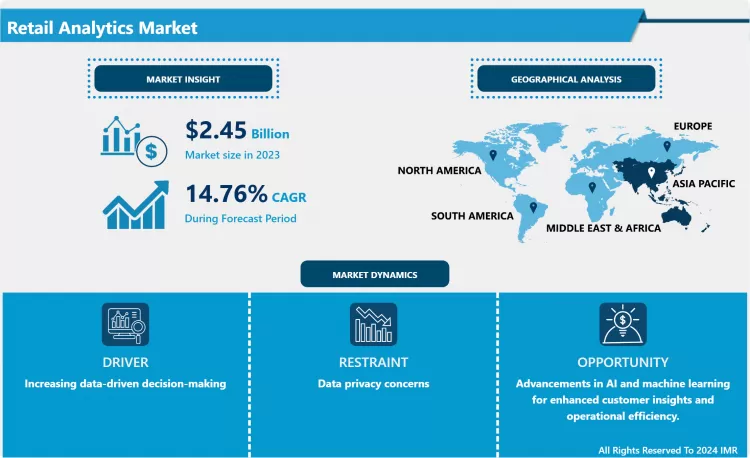Retail Analytics Market Synopsis
Retail Analytics Market Size is Valued at USD 2.45 Billion in 2023, and is Projected to Reach USD 7.39 Billion by 2032, Growing at a CAGR of 14.76% From 2024-2032.
The retail analytics market is a rapidly growing sector that leverages data-driven insights to enhance decision-making, optimize operations, and drive sales in the retail industry. By utilizing technologies such as big data, machine learning, and artificial intelligence, retailers can gain a deeper understanding of consumer behavior, inventory management, and sales trends. This market is fueled by the increasing adoption of advanced analytics tools, the rise of e-commerce, and the growing need for personalized shopping experiences. As retailers seek to stay competitive and meet evolving customer expectations, the demand for sophisticated analytics solutions continues to expand, driving innovation and growth within the industry.
- The retail analytics market has been expanding rapidly as retailers strive to improve their operational efficiency and consumer experiences by utilizing data-driven insights. This market includes technologies and tools that facilitate strategic decision-making by analyzing consumer behavior, sales trends, and inventory management.
- Artificial intelligence and machine learning, which offer predictive capabilities and deeper insights, are driving the market. These technologies allow retailers to enhance customer satisfaction, optimize supply chains, and personalize marketing strategies.
- The growth of e-commerce and omnichannel retailing has further exacerbated the demand for retail analytics. Retailers are employing analytics to integrate data from a variety of channels, thereby identifying opportunities for development and ensuring a seamless customer experience.
- Investment in retail analytics is becoming increasingly necessary for businesses that wish to maintain a competitive edge amid increasing competition. We anticipate that the market will continue to expand due to technological advancements and the growing demand for actionable insights in a dynamic retail environment.


Retail Analytics Market Trend Analysis
Artificial Intelligence and Machine Learning
- Advancements in artificial intelligence (AI) and machine learning (ML) are substantially driving a transformative shift in the retail analytics market. These technologies are transforming the way in which retailers capture, analyze, and utilize data, thereby improving operational efficiency and decision-making processes. AI and ML algorithms have the capacity to analyze immense quantities of consumer data, revealing patterns and insights that were previously unavailable. This allows retailers to more effectively customize their strategies.
- To be more specific, AI-powered tools enhance inventory management by accurately anticipating demand, thereby reducing overstock and stockouts. In order to maximize stock levels and streamline supply chains, machine learning models analyze consumer behavior, seasonal fluctuations, and purchasing trends. This leads to improved service for customers, more efficient operations, and cost savings for retailers.
- Furthermore, AI and ML are implementing personalized marketing strategies to enhance the consumer experience. These technologies can enhance engagement and conversion rates by segmenting consumers and delivering targeted promotions based on browsing and purchase history. Retailers can cultivate a more personalized shopping experience by employing predictive analytics to anticipate customer requirements and preferences.
- As the retail landscape becomes more data-driven, AI and ML are poised to play a critical role in the future of retail analytics. The capacity to harness and interpret data in real-time enables retailers to remain competitive, quickly adapt to market changes, and offer a more personalized purchasing experience. We anticipate significant growth and innovation in the retail analytics market.
Omnichannel Integration
- Omnichannel integration is transforming the retail analytics market, resulting in a more cohesive purchasing experience for consumers. Retailers are increasingly implementing omnichannel strategies to establish a seamless connection between online and offline channels, thereby delivering a unified consumer experience. This method is essential for comprehending consumer preferences and behavior, as it facilitates enhanced data collection and analysis across all touchpoints.
- The increasing prevalence of omnichannel integration is driving the demand for sophisticated retail analytics tools. These tools assist retailers in consolidating data from a variety of channels, including in-store, mobile, and e-commerce platforms, into a unified view. Ultimately, this exhaustive data set enhances customer satisfaction and loyalty by enabling more precise forecasting, targeted marketing, and personalized recommendations.
- Furthermore, omnichannel integration facilitates real-time analytics, which allows retailers to promptly make data-driven decisions. This agility is essential for optimizing inventory management, adjusting strategies as needed, and responding to market trends and consumer needs. In a market that is swiftly evolving, retailers that capitalize on these insights can establish a competitive advantage.
- The convergence of retail analytics and omnichannel integration is generally transforming the retail landscape. Retailers that effectively leverage these trends will be better positioned to flourish in the dynamic retail environment as technology advances and consumer expectations shift.
Retail Analytics Market Segment Analysis:
Retail Analytics Market Segmented on the basis of By Component Type and By Organization Size
By Component Type, Services segment is expected to dominate the market during the forecast period
- Retail analytics has become an essential instrument for improving consumer experiences and optimizing performance. We can gain a more comprehensive understanding of how various components influence the growth and functionality of the market by dividing it into services and solutions.
- Services in retail analytics include consulting, implementation, and support. These services assist retailers in integrating analytics tools into their operations, thereby providing expertise in the generation of insights and the administration of data. For example, consulting services provide retailers with guidance on how to utilize data to make strategic decisions, while support services guarantee efficient operation and troubleshooting.
- We refer to the software and technological instruments used for data analysis and visualization as solutions. These platforms encompass inventory management, sales forecasting, and consumer behavior analysis. Advanced solutions use machine learning and AI to provide predictive analytics, helping retailers predict trends and optimize supply levels.
- Retail analytics services and solutions promote innovation and efficiency, thereby allowing retailers to improve their comprehension of their consumers, optimize operations, and, in the end, increase profitability.
By Organization Size, Large Enterprises segment held the largest share in 2024
- Advancements in technology and a growing demand for data-driven decision-making are driving significant growth in the retail analytics market. Large enterprises, owing to their extensive operations and vast resources, are employing sophisticated analytics tools to optimize their supply chain, improve the customer experience, and increase overall efficacy. These organizations are making substantial investments in comprehensive analytics platforms to enhance personalization, leverage big data, and establish a competitive advantage in the market.
- In contrast, small and medium enterprises (SMEs) are also more frequently implementing retail analytics solutions, albeit on a more limited scale. These organizations are emphasizing tools that are both user-friendly and affordable, and that offer actionable insights without the need for extensive technical expertise. By streamlining inventory management, enhancing customer engagement, and facilitating targeted marketing efforts, retail analytics can assist SMEs in competing with their larger counterparts.
- The increasing prevalence of cloud-based analytics solutions is a substantial factor that has enabled both large enterprises and small and medium-sized enterprises to capitalize on retail analytics. Advanced analytics are now accessible to a wider variety of businesses due to the cost-efficiency, flexibility, and scalability of cloud technology. The democratization of data insights is revolutionizing the way in which companies of all sizes approach retail strategy and operations.
- In general, the retail analytics market is adapting to meet the diverse requirements of both large enterprises and small and medium-sized enterprises. We can anticipate additional innovations that will improve data analysis capabilities and facilitate more customized strategies in the retail sector as technology continues to evolve.
Active Key Players in the Retail Analytics Market
- IBM Corporation (United States)
- MRI Software (United States)
- Tech Mahindra (India)
- Retail Insights (United States)
- Snowflake Inc. (United States)
- NielsenIQ (United States)
- Salesforce.Com Inc. (United States)
- Oracle Corporation (United States)
- Wipro Limited (India)
- Fractal Analytics Inc. (United States), Others.
|
Global Retail Analytics Market |
|||
|
Base Year: |
2023 |
Forecast Period: |
2024-2032 |
|
Historical Data: |
2017 to 2023 |
Market Size in 2023: |
USD 2.45 Bn. |
|
Forecast Period 2024-32 CAGR: |
14.76% |
Market Size in 2032: |
USD 7.39 Bn. |
|
Segments Covered: |
By Component Type |
|
|
|
By Organization Size |
|
||
|
By Region |
|
||
|
Key Market Drivers: |
|
||
|
Key Market Restraints: |
|
||
|
Key Opportunities: |
|
||
|
Companies Covered in the report: |
|
||
1.1 Scope and Coverage
Chapter 2:Executive Summary
Chapter 3: Market Landscape
3.1 Market Dynamics
3.1.1 Drivers
3.1.2 Restraints
3.1.3 Opportunities
3.1.4 Challenges
3.2 Market Trend Analysis
3.3 PESTLE Analysis
3.4 Porter's Five Forces Analysis
3.5 Industry Value Chain Analysis
3.6 Ecosystem
3.7 Regulatory Landscape
3.8 Price Trend Analysis
3.9 Patent Analysis
3.10 Technology Evolution
3.11 Investment Pockets
3.12 Import-Export Analysis
Chapter 4: Retail Analytics Market by Component Type (2018-2032)
4.1 Retail Analytics Market Snapshot and Growth Engine
4.2 Market Overview
4.3 Services
4.3.1 Introduction and Market Overview
4.3.2 Historic and Forecasted Market Size in Value USD and Volume Units
4.3.3 Key Market Trends, Growth Factors, and Opportunities
4.3.4 Geographic Segmentation Analysis
4.4 Solutions
Chapter 5: Retail Analytics Market by Organization Size (2018-2032)
5.1 Retail Analytics Market Snapshot and Growth Engine
5.2 Market Overview
5.3 Large Enterprises and Small and Medium Enterprises
5.3.1 Introduction and Market Overview
5.3.2 Historic and Forecasted Market Size in Value USD and Volume Units
5.3.3 Key Market Trends, Growth Factors, and Opportunities
5.3.4 Geographic Segmentation Analysis
Chapter 6: Company Profiles and Competitive Analysis
6.1 Competitive Landscape
6.1.1 Competitive Benchmarking
6.1.2 Retail Analytics Market Share by Manufacturer (2024)
6.1.3 Industry BCG Matrix
6.1.4 Heat Map Analysis
6.1.5 Mergers and Acquisitions
6.2 IBM CORPORATION (UNITED STATES)
6.2.1 Company Overview
6.2.2 Key Executives
6.2.3 Company Snapshot
6.2.4 Role of the Company in the Market
6.2.5 Sustainability and Social Responsibility
6.2.6 Operating Business Segments
6.2.7 Product Portfolio
6.2.8 Business Performance
6.2.9 Key Strategic Moves and Recent Developments
6.2.10 SWOT Analysis
6.3 MRI SOFTWARE (UNITED STATES)
6.4 TECH MAHINDRA (INDIA)
6.5 RETAIL INSIGHTS (UNITED STATES)
6.6 SNOWFLAKE INC. (UNITED STATES)
6.7 NIELSENIQ (UNITED STATES)
6.8 SALESFORCE.COM INC. (UNITED STATES)
6.9 ORACLE CORPORATION (UNITED STATES)
6.10 WIPRO LIMITED (INDIA)
6.11 FRACTAL ANALYTICS INC. (UNITED STATES)
6.12 OTHERS
Chapter 7: Global Retail Analytics Market By Region
7.1 Overview
7.2. North America Retail Analytics Market
7.2.1 Key Market Trends, Growth Factors and Opportunities
7.2.2 Top Key Companies
7.2.3 Historic and Forecasted Market Size by Segments
7.2.4 Historic and Forecasted Market Size by Component Type
7.2.4.1 Services
7.2.4.2 Solutions
7.2.5 Historic and Forecasted Market Size by Organization Size
7.2.5.1 Large Enterprises and Small and Medium Enterprises
7.2.6 Historic and Forecast Market Size by Country
7.2.6.1 US
7.2.6.2 Canada
7.2.6.3 Mexico
7.3. Eastern Europe Retail Analytics Market
7.3.1 Key Market Trends, Growth Factors and Opportunities
7.3.2 Top Key Companies
7.3.3 Historic and Forecasted Market Size by Segments
7.3.4 Historic and Forecasted Market Size by Component Type
7.3.4.1 Services
7.3.4.2 Solutions
7.3.5 Historic and Forecasted Market Size by Organization Size
7.3.5.1 Large Enterprises and Small and Medium Enterprises
7.3.6 Historic and Forecast Market Size by Country
7.3.6.1 Russia
7.3.6.2 Bulgaria
7.3.6.3 The Czech Republic
7.3.6.4 Hungary
7.3.6.5 Poland
7.3.6.6 Romania
7.3.6.7 Rest of Eastern Europe
7.4. Western Europe Retail Analytics Market
7.4.1 Key Market Trends, Growth Factors and Opportunities
7.4.2 Top Key Companies
7.4.3 Historic and Forecasted Market Size by Segments
7.4.4 Historic and Forecasted Market Size by Component Type
7.4.4.1 Services
7.4.4.2 Solutions
7.4.5 Historic and Forecasted Market Size by Organization Size
7.4.5.1 Large Enterprises and Small and Medium Enterprises
7.4.6 Historic and Forecast Market Size by Country
7.4.6.1 Germany
7.4.6.2 UK
7.4.6.3 France
7.4.6.4 The Netherlands
7.4.6.5 Italy
7.4.6.6 Spain
7.4.6.7 Rest of Western Europe
7.5. Asia Pacific Retail Analytics Market
7.5.1 Key Market Trends, Growth Factors and Opportunities
7.5.2 Top Key Companies
7.5.3 Historic and Forecasted Market Size by Segments
7.5.4 Historic and Forecasted Market Size by Component Type
7.5.4.1 Services
7.5.4.2 Solutions
7.5.5 Historic and Forecasted Market Size by Organization Size
7.5.5.1 Large Enterprises and Small and Medium Enterprises
7.5.6 Historic and Forecast Market Size by Country
7.5.6.1 China
7.5.6.2 India
7.5.6.3 Japan
7.5.6.4 South Korea
7.5.6.5 Malaysia
7.5.6.6 Thailand
7.5.6.7 Vietnam
7.5.6.8 The Philippines
7.5.6.9 Australia
7.5.6.10 New Zealand
7.5.6.11 Rest of APAC
7.6. Middle East & Africa Retail Analytics Market
7.6.1 Key Market Trends, Growth Factors and Opportunities
7.6.2 Top Key Companies
7.6.3 Historic and Forecasted Market Size by Segments
7.6.4 Historic and Forecasted Market Size by Component Type
7.6.4.1 Services
7.6.4.2 Solutions
7.6.5 Historic and Forecasted Market Size by Organization Size
7.6.5.1 Large Enterprises and Small and Medium Enterprises
7.6.6 Historic and Forecast Market Size by Country
7.6.6.1 Turkiye
7.6.6.2 Bahrain
7.6.6.3 Kuwait
7.6.6.4 Saudi Arabia
7.6.6.5 Qatar
7.6.6.6 UAE
7.6.6.7 Israel
7.6.6.8 South Africa
7.7. South America Retail Analytics Market
7.7.1 Key Market Trends, Growth Factors and Opportunities
7.7.2 Top Key Companies
7.7.3 Historic and Forecasted Market Size by Segments
7.7.4 Historic and Forecasted Market Size by Component Type
7.7.4.1 Services
7.7.4.2 Solutions
7.7.5 Historic and Forecasted Market Size by Organization Size
7.7.5.1 Large Enterprises and Small and Medium Enterprises
7.7.6 Historic and Forecast Market Size by Country
7.7.6.1 Brazil
7.7.6.2 Argentina
7.7.6.3 Rest of SA
Chapter 8 Analyst Viewpoint and Conclusion
8.1 Recommendations and Concluding Analysis
8.2 Potential Market Strategies
Chapter 9 Research Methodology
9.1 Research Process
9.2 Primary Research
9.3 Secondary Research
|
Global Retail Analytics Market |
|||
|
Base Year: |
2023 |
Forecast Period: |
2024-2032 |
|
Historical Data: |
2017 to 2023 |
Market Size in 2023: |
USD 2.45 Bn. |
|
Forecast Period 2024-32 CAGR: |
14.76% |
Market Size in 2032: |
USD 7.39 Bn. |
|
Segments Covered: |
By Component Type |
|
|
|
By Organization Size |
|
||
|
By Region |
|
||
|
Key Market Drivers: |
|
||
|
Key Market Restraints: |
|
||
|
Key Opportunities: |
|
||
|
Companies Covered in the report: |
|
||
Frequently Asked Questions :
The forecast period in the Retail Analytics Market research report is 2024-2032.
IBM Corporation (United States), MRI Software (United States), Tech Mahindra (India), Retail Insights (United States), Snowflake Inc. (United States), NielsenIQ (United States), Salesforce.Com Inc. (United States), Oracle Corporation (United States), Wipro Limited (India), Fractal Analytics Inc. (United States)
The Retail Analytics Market is segmented into By Component Type (Services and Solutions), By Organization Size (Large Enterprises and Small and Medium Enterprises). By region, it is analyzed across North America (U.S.; Canada; Mexico), Eastern Europe (Bulgaria; The Czech Republic; Hungary; Poland; Romania; Rest of Eastern Europe), Western Europe (Germany; UK; France; Netherlands; Italy; Russia; Spain; Rest of Western Europe), Asia-Pacific (China; India; Japan; Southeast Asia, etc.), South America (Brazil; Argentina, etc.), Middle East & Africa (Saudi Arabia; South Africa, etc.).
Retail analytics refers to the use of data analysis tools and techniques to gain insights into various aspects of retail operations. By analyzing sales data, customer behavior, inventory levels, and market trends, retailers can make informed decisions to optimize their strategies. This includes improving inventory management, personalizing customer experiences, and enhancing overall operational efficiency. Retail analytics helps businesses identify patterns and trends, predict future sales, and tailor marketing efforts to better meet customer needs, ultimately driving profitability and growth.
Retail Analytics Market Size is Valued at USD 2.45 Billion in 2024, and is Projected to Reach USD 7.39 Billion by 2032, Growing at a CAGR of 14.76% From 2024-2032.













